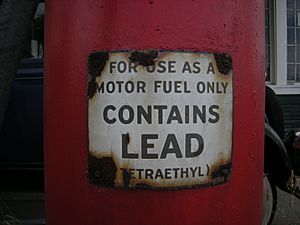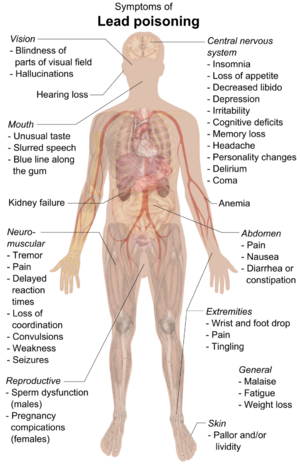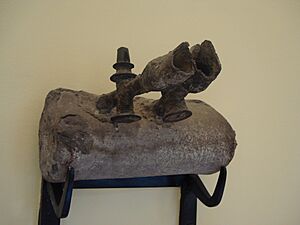Lead poisoning facts for kids
Lead poisoning happens when there is too much lead in a person's body. Lead is a metal that can be very harmful, or toxic, even in small amounts. It can damage many parts of the body, including the brain, nerves, and other organs. When someone has lead poisoning, doctors usually try to find out where the lead is coming from and remove that source.
Contents
What is Lead?
Lead is a heavy metal found naturally in the Earth's crust. For a long time, people used lead in many products because it was cheap and easy to work with. It was used in things like paint, water pipes, gasoline, and even some toys. However, we now know that lead is very dangerous to human health.
How Does Lead Get Into Our Bodies?
Lead can enter your body in different ways. The most common way is by breathing in lead dust or by swallowing small pieces of lead. This can happen if you:
- Live in an old house with lead paint that is chipping or peeling.
- Drink water from old pipes that contain lead.
- Are near places where lead was used, like old factories or areas with leaded gasoline fumes.
- Touch things with lead and then put your hands in your mouth.
- Work with lead, like in battery recycling plants.
Lead can also be found in some older products, like certain kinds of pottery, jewelry, or even some traditional medicines.
How Lead Harms Your Body
When lead gets into your body, it can cause many problems because it interferes with how your cells work. It can affect almost every organ system.
Effects on the Brain and Nerves
Lead is especially harmful to the brain and nervous system, particularly in children.
- It can make it harder to learn and pay attention.
- It might cause problems with memory.
- It can affect how you think and behave.
- In severe cases, it can cause serious brain damage.

Other Body Systems
Lead can also harm other parts of your body:
- Blood: It can affect the production of red blood cells, leading to anemia (when your blood doesn't carry enough oxygen).
- Bones: Lead can be stored in your bones for a long time.
- Kidneys: It can damage your kidneys, which help filter waste from your blood.
- Digestion: It can cause stomach pain, constipation, or nausea.
Symptoms of Lead Poisoning
The symptoms of lead poisoning can be different for everyone and depend on how much lead is in the body. Sometimes, people don't show any symptoms at first, especially if the lead levels are low.
Common symptoms can include:
- Stomach aches or cramps
- Headaches
- Feeling tired or weak
- Loss of appetite
- Weight loss
- Trouble sleeping
- Being irritable or moody
- Having difficulty concentrating
In more serious cases, lead poisoning can cause seizures, coma, or even death. This is why it's so important to prevent lead exposure.
Finding and Treating Lead Poisoning
Doctors can check for lead in your body with a simple blood test. If someone has lead poisoning, the first step is always to remove the source of lead. This might mean:
- Cleaning up lead dust in a home.
- Replacing old lead pipes.
- Avoiding certain products that contain lead.
For very high levels of lead, doctors might use a special treatment called chelation therapy. This involves giving medicines that help the body remove lead.
Preventing Lead Poisoning
The best way to deal with lead poisoning is to prevent it from happening. Here are some ways to stay safe:
- Wash your hands often, especially before eating.
- Keep your home clean and dust-free.
- If you live in an old house, be careful about chipping paint.
- Don't chew on painted surfaces.
- Eat healthy foods, as a good diet can help your body absorb less lead.
- If you or your family work with lead, make sure to follow safety rules.
History of Lead Use
People have known about lead for thousands of years. The ancient Romans used lead for water pipes and in some of their tools. However, even then, some people noticed that lead could make people sick. For example, Dioscorides, a Greek doctor in the first century AD, wrote about lead's harmful effects on the mind.
Over time, as more was learned about lead's dangers, its use in many products like paint and gasoline was stopped in many countries. However, lead can still be found in the environment from past uses, and it's important to be aware of the risks.
Images for kids
-
Lead exposure can damage cells in the hippocampus, a part of the brain important for memory.
See also
 In Spanish: Saturnismo para niños
In Spanish: Saturnismo para niños









